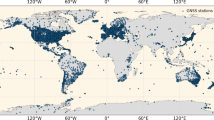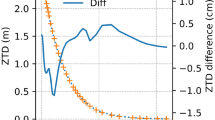Abstract
Single-frequency Global Navigation Satellite System (GNSS) users require an efficient ionospheric delay correction model for improving their positional accuracy. GPS satellite range signals undergo time delay through the inhomogeneous and dynamic state of the ionosphere. The ionospheric delay is inverse proportional to the signal frequency square due to the dispersive nature of the ionospheric medium. There is a need for aid regional ionospheric broadcast correction model that is necessary for low-latitude ionospheric conditions. In this paper, a reduced order adjusted spherical harmonics function (ROASHF) ionospheric broadcast correction model with order and degree 2 is proposed for the Indian region. A dense GPS receiver network of 14 GPS receivers over the Indian region is analyzed to derive nine ROASHF broadcast coefficients. The performance of the proposed ionospheric broadcast correction model is compared with Klobuchar, NeQuickG, BDS-2, CODEKlob, and CODEGIM TEC models during March and September equinox and June and December solstice days in 2015 and 2016. The mean root mean square error (RMSE) of ROASHF, Klobuchar, NeQuickG, BDS-2, CODEKlob, and CODEGIM TEC models is 7.13 TECU, 9.52 TECU, 15.52 TECU, 11.44 TECU, 13.47 TECU, and 11.97 TECU, respectively. The results demonstrated that the proposed ROASHF ionospheric broadcast model could better predict the ionospheric delays for single-frequency GNSS users. The proposed ionospheric broadcast model is suitable for the Indian regional navigation system known as Navigation with Indian Constellation (NavIC).











Similar content being viewed by others
References
China Satellite Navigation Office, ICD B(2017) BeiDou navigation satellite system signal in space interface control document—openservice signals B1C (Version 1.0)
China Satellite Navigation Office (2019) BeiDou navigation satellite system signal in space interface control document open service signal B1I (Version 3.0)
Dabbakuti JK, Ratnam DV, Sunda S (2016) Modelling of ionospheric time delays based on adjusted spherical harmonic analysis. Aviation 20:1–7
Feess W, Stephens S (1987) Evaluation of GPS ionospheric time-delay model. IEEE Transactions on Aerospace and Electronic Systems:332–338
Han L, Zhang H, Huang Y, Wang M, Zhu W, Ping J Improving Klobuchar type ionospheric delay model using 2D GPS TEC over China. In: 36thCOSPAR Scientific Assembly, 2006.
Hopkins J (1973) Computation of normalized associated Legendre functions using recursive relations. J Geophys Res 78:476–477
Hoque MM, Jakowski N, Berdermann J (2017) Ionospheric correction using NTCM driven by GPS Klobuchar coefficients for GNSS applications. GPS Solut 21:1563–1572
Klobuchar JA (1987) Ionospheric time-delay algorithm for single-frequency GPS users. IEEE Trans Aerosp Electron Syst. AES-23(3):325–331
Langley RB, Fedrizzi M, de Paula ER, Kantor IJ, Santos MC, Komjathy A (2002) Mapping the low-latitude ionosphere with GPS. GPS WORLD 13:41–47
Li Z, Wang N, Wang L, Liu A, Yuan H, Zhang K (2019) Regional ionospheric TEC modeling based on a two-layer spherical harmonic approximation for real-time single-frequency PPP. J Geodesy 93:1659–1671
MOPS W (1999) Minimum operational performance standards for global positioning system/wide area augmentation system airborne equipment. RTCA Inc Documentation No RTCA/DO-229B 6
Nava B, Coisson P, Radicella S (2008) A new version of the NeQuick ionosphere electron density model. J Atmos Solar Terr Phys 70:1856–1862
Nishimoto K, Ohashi M, Kubo Y, Sugimoto S (2013) Determination of the parameters of a Japanese- regional Klobuchar ionospheric model based on GR models and SCH analysis by GEONET data. In: Proceeding of ION Pacific PNT Meeting, pp 723–734
Oladipo O, Schüler T (2012) GNSS single frequency ionospheric range delay corrections: NeQuick data ingestion technique. Adv Space Res 50:1204–1212
Prieto-Cerdeira R, Orus-Peres R, Breeuwer E, Lucas-Rodriguez R, Falcone M (2014) Performance of the Galileo single-frequency ionospheric correction during in-orbit validation. GPS WORLD 25:53–58
Radvilaitė U, Ramírez-Gómez Á, Jaras A, Kačianauskas R, Rusakevičius D (2016) Low- resolution spherical harmonics models in application to quasi-quadric particle shapes. Engineering Structures and Technologies 8:131–142
Rao PR, Niranjan K, Prasad D, Krishna SG, Uma G (2006) On the validity of the ionospheric pierce point (IPP) altitude of 350 km in the Indian equatorial and low-latitude sector. Ann Geophys 8:2159–2168
Ratnam DV (2013) Estimation and analysis of user IPP delays using bilinear model for satellite- based augmented navigation systems. Aviation 17:65–69
Ratnam DV, Dabbakuti JK, Sunda S (2017) Modeling of ionospheric time delays based on a multishell spherical harmonics function approach. IEEE J Selected Topics Appl Earth Observ Remote Sens 10:5784–5790
Ratnam DV, Sarma A (2011) Modeling of low-latitude ionosphere using GPS data with SHF model. IEEE Trans Geosci Remote Sens 50:972–980
Schaer S, géodésique ShdsnC, (1999)Mapping and predicting the Earth's ionosphere using the Global Positioning System, vol. 59. Technische Hochschule Zürich Institut für Geodäsie und Photogrammetrie, Eidg
Shukla AK, Das S, Shukla AP, Palsule VS (2013) Approach for near-real-time prediction of ionospheric delay using Klobuchar-like coefficients for Indian region. IET Radar Sonar Navig 7:67–74
Wang N, Li Z, Huo X, Li M, Yuan Y, Yuan C (2019) Refinement of global ionospheric coefficients for GNSS applications: Methodology and results. Adv Space Res 63:343–358
Wu X, Hu X, Wang G, Zhong H, Tang C (2013) Evaluation of COMPASS ionospheric model in GNSS positioning. Adv Space Res 51:959–968
Wu X, Zhou J, Tang B, Cao Y, Fan J (2014) Evaluation of COMPASS ionospheric grid. GPS Solutions 18:639–649
Yuan Y, Huo X, Ou J (2005) Development of a new GNSS broadcast ionospheric time delay correction model (IGGSH). In: Proceedings of the International Symposium on GPS/GNSS, December 8–10, Hong Kong.
Yuan Y, Huo X, Ou J, Zhang K, Chai Y, Wen D, Grenfell R (2008) Refining the Klobuchar ionospheric coefficients based on GPS observations. IEEE Trans Aerosp Electron Syst 44:1498–1510
Yuan Y, Li Z, Huo X, Wang N (2014) A next-generation broadcast model (BDSSH) and its implementation scheme of ionospheric time delay correction for BDS/GNSS. In: Proceedings of the ION GNSS+ 2014, September 8–12, Tampa
Yuan Y, Wang N, Li Z, Huo X (2019) The BeiDou global broadcast ionospheric delay correction model (BDGIM) and its preliminary performance evaluation results. Navigation 66:55–69
Acknowledgements
The present work has been carried out under the project titled ‘Development of Single Frequency Ionospheric correction & plasma bubble detection algorithms using GPS Aided GEO Augmented Navigation (GAGAN) & Navigation Indian Constellation (NavIC) TEC observations’ sponsored by NavIC– GAGAN Utilization Programme at Space Applications Centre, Ahmedabad, India, Project ID: NGP-10.
Author information
Authors and Affiliations
Corresponding author
Additional information
Communicated by Theodore Karacostas, Prof. (CO-EDITOR-IN-CHIEF)/Andrzej Krankowski (ASSOCIATE EDITOR).
Rights and permissions
About this article
Cite this article
Abhigna, M.S.R., Sridhar, M., Harsha, P.B.S. et al. Broadcast ionospheric delay correction algorithm using reduced order adjusted spherical harmonics function for single-frequency GNSS receivers. Acta Geophys. 69, 335–351 (2021). https://doi.org/10.1007/s11600-020-00515-z
Received:
Accepted:
Published:
Issue Date:
DOI: https://doi.org/10.1007/s11600-020-00515-z




